Suite and Dances
Course
Learn How to Compose a Baroque-Style Suite with All the Dances
Unveil the rhythms of Baroque dances, master the art of phrasing and cadence, and craft your own suite with the graceful steps of the 17th century.
Every self-respecting 18th-century composer wrote at least one suite featuring a variety of dances: allemande, courante, sarabande, gigue, and more.
But that’s just the beginning!
Every composition, every piece, every musical phrase starts with rhythm—and rhythm is the very soul of dance.
So, learning how to compose a Baroque-style suite, with its different dance movements, also means learning how to write musical phrases with clear rhythmic profiles; solid, balanced phrases that sound stylistically authentic, as if they were crafted by a true master of the 18th century.
That’s exactly what we’ll do together in this level of the Baroque Path at the Musicus Practicus Academy.
- We’ll dive into the unique character of each dance: its phrasing, tempo, and compositional techniques.
- We’ll analyze a wide range of dances by composers such as Bach, Handel, Corelli, Vivaldi, Dandrieu, and Couperin.
- We’ll also explore a bit of historical background to place each dance in its proper context.
- And then we’ll compose two complete suites together: one in B-flat major and the other in B minor—combining rhythm, harmonic and contrapuntal patterns, and diminutions.
(By the way, you can listen to both suites below, on this page.)
By the end of the Suite and Dances Course, you will be able to:
🎵 Identify the dances that make up a Baroque suite
🎵 Compose musical phrases that reflect the unique rhythm of each dance
🎵 Analyze any dance within a suite and recognize its defining stylistic features
🎵 Write multiple Allemandes using a variety of compositional techniques
🎵 Compose Sarabandes in both 3/2 and 3/4 meter
🎵 Create Minuets in both simple and Rondeau form
🎵 Write Gavottes and Bourrées to include in the central section of your suite
🎵 Compose Loures and Passepieds with contrasting character
🎵 Differentiate between and compose both French Courantes and Italian Correnti
🎵 Write both French and Italian Gigues, capturing their distinctive rhythms and phrasing
🎵 Compose and assemble a complete Baroque suite—ready to publish as your own personal collection!
Course Contents
Chapter 1: Allemande
Learn the Phrasing of the Allemande and Discover the Role of Arsis and Thesis in Baroque Dances.
Learn the Cadential Plans of the Allemande, Useful for Any Dance in the Baroque Style.
Compose Two Allemandes in Different Styles and Keys!
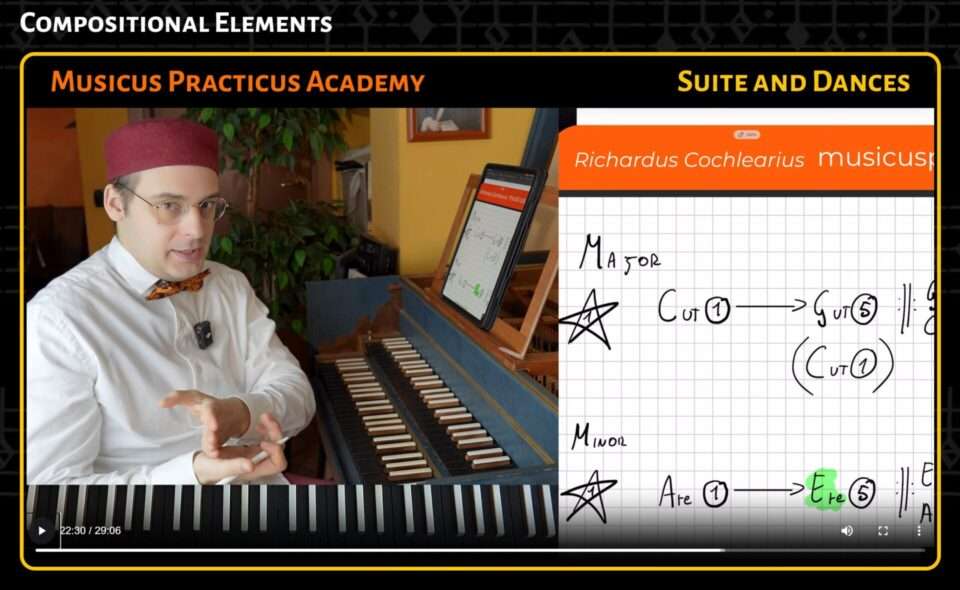
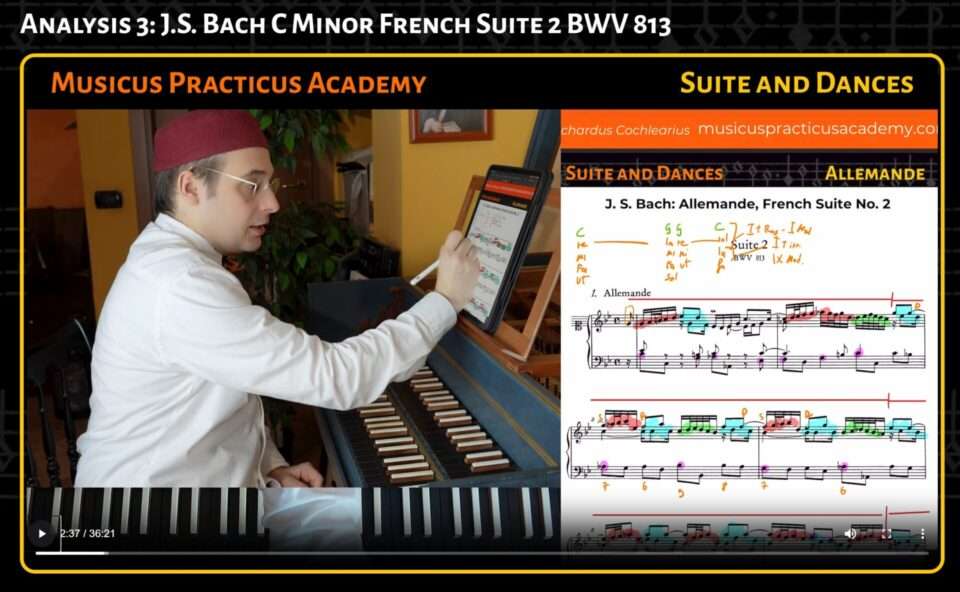
Stages
🎼 1.1 – Allemande – Resources for the Musicus
🎼 1.2 – Compositional Elements
🎼 1.3 – Analysis 1: G.F. Handel, A Major HWV 477
🎼 1.4 – Analysis 2: J.J. Froberger, G Minor, Suite XVIII
🎼 1.5 – Analysis 3: J.S. Bach C Minor French Suite 2 BWV 813
🎼 1.6 – Allemande: Historical Sources
🎼 1.7 – Allemande: AI Audio Podcast
🎼 1.8 – Composition 1: Bflat Major Allemande
🎼 1.9 – Composition 2: B Minor Allemande
Chapter 2: Sarabande
Learn the Idiomatic Rhythms of the Sarabande and How to Use the Typical Sarabande Syncopation.
Analyze Majestic Original Sarabandes from the French Tradition.
Compose Two Sarabandes Using the Rhythms and Phrases You’ve Learned and Analyzed.
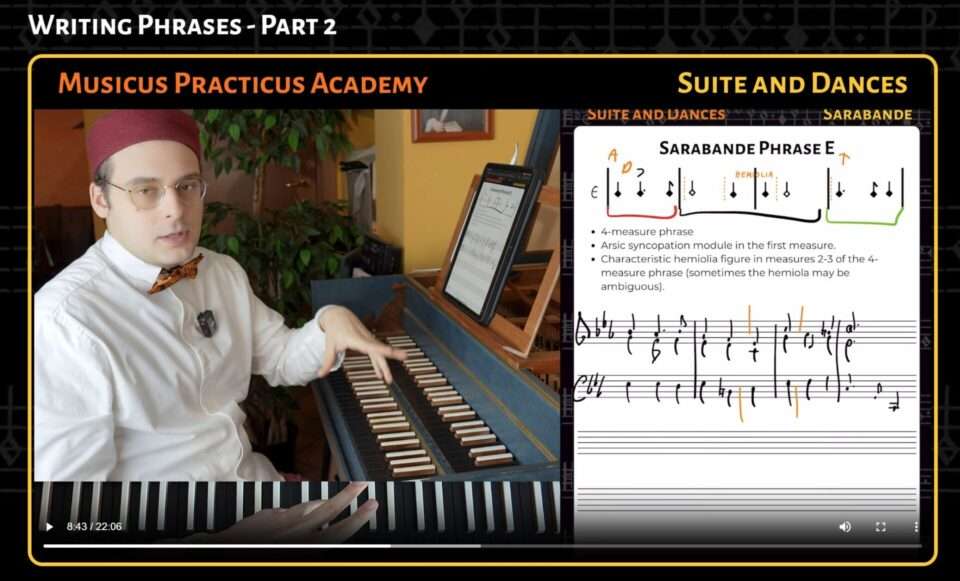
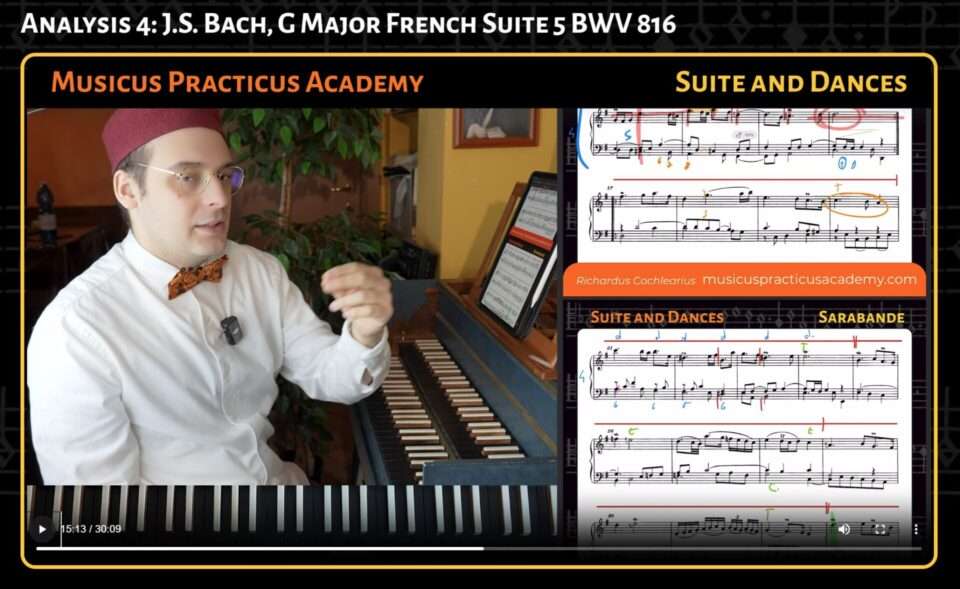
Stages
🎼 2.1 – Sarabande – Resources for the Musicus
🎼 2.2 – Compositional Elements
🎼 2.3 – Writing Phrases – Part 1
🎼 2.4 – Writing Phrases – Part 2
🎼 2.5 – Analysis 1: C. Dieupart, F Minor
🎼 2.6 – Analysis 2: Louis Couperin B Minor
🎼 2.7 – Analysis 3: J.S. Bach, D Minor French Suite 1 BWV 812
🎼 2.8 – Analysis 4: J.S. Bach, G Major French Suite 5 BWV 816
🎼 2.9 – Sarabande: Historical Sources
🎼 2.10 – Sarabande: AI Audio Podcast
🎼 2.11 – Composition 1: Bflat Major Sarabande
🎼 2.12 – Composition 2: B Minor Sarabande
Chapter 3: Menuet
Learn the Rhythms of the Minuet and Discover All the Ways to Beat the Tactus.
Analyze Minuets by French Composers and by J. S. Bach.
Learn to Compose a Menuet and a Menuet en Rondeau.
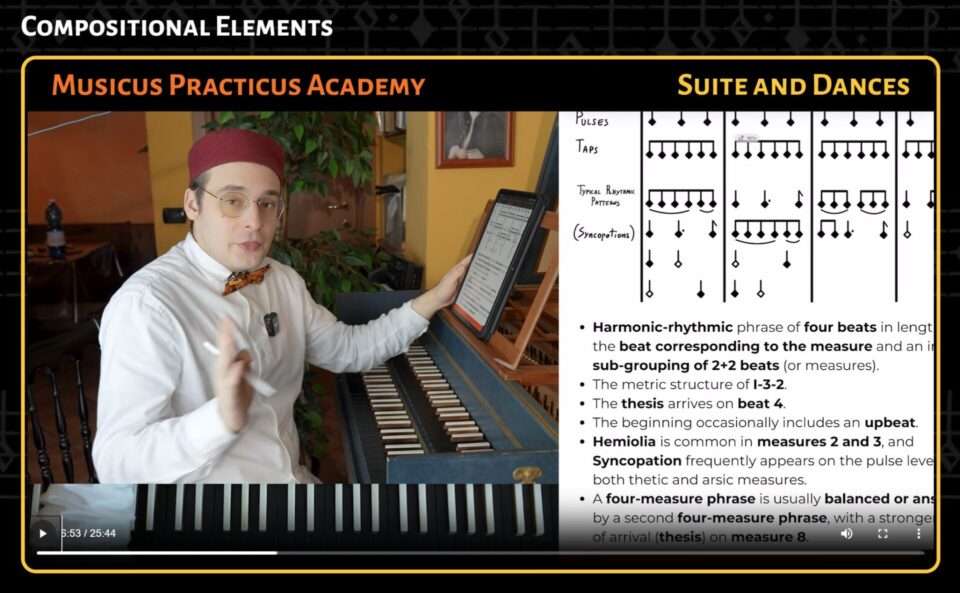
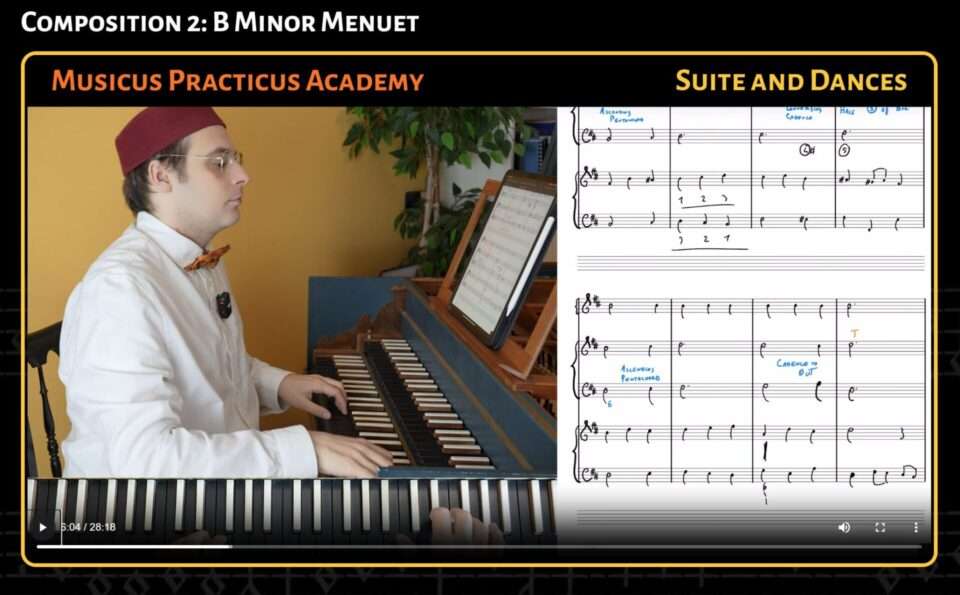
Stages
🎼 3.1 – Menuet – Resources for the Musicus
🎼 3.2 – Compositional Elements
🎼 3.3 – Analysis 1: Dandrieu, C Minor
🎼 3.4 – Analysis 2: Dandrieu D Minor
🎼 3.5 – Analysis 3: Couperin, C Minor
🎼 3.6 – Analysis 4: J.S. Bach, B Minor French Suite n. 3 Menuet I
🎼 3.7 – Analysis 5: J.S. Bach, B Minor French Suite n. 3 Menuet II
🎼 3.8 – Meneut: Historical Sources
🎼 3.9 – Menuet: AI Audio Podcast
🎼 3.10 – Composition 1: Bflat Major Menuet
🎼 3.11 – Composition 2: B Minor Menuet
Chapter 4: Gavotte
Learn the Rhythms and Phrasing of the Gavotte, and How to Distinguish a French Gavotte from an Italian Gavotta.
Analyze Simple Gavottes as Well as Spicier Ones by Unexpected Composers!
Learn to Compose a Gavotte; Actually, Two: One Simple and One in Canon!
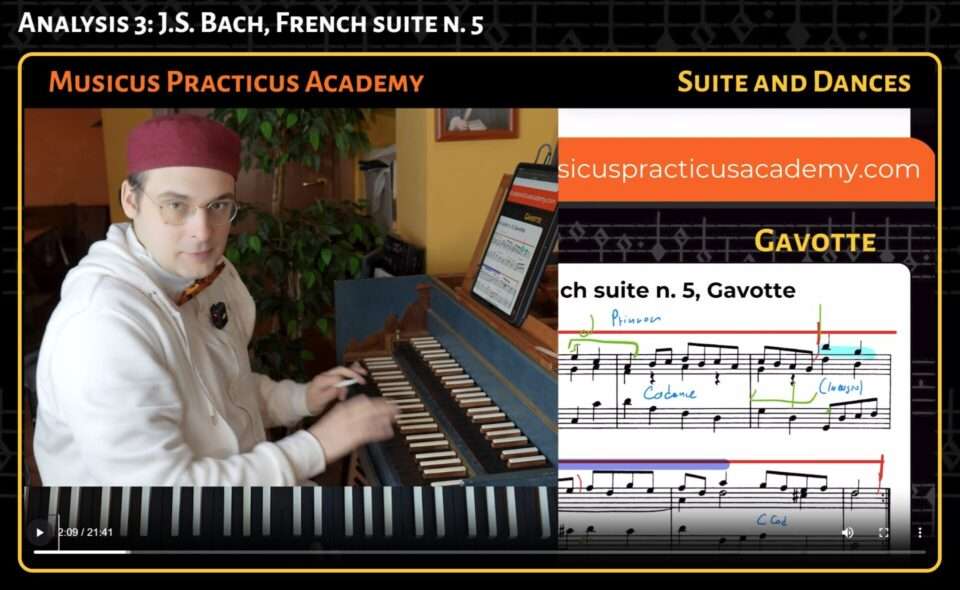
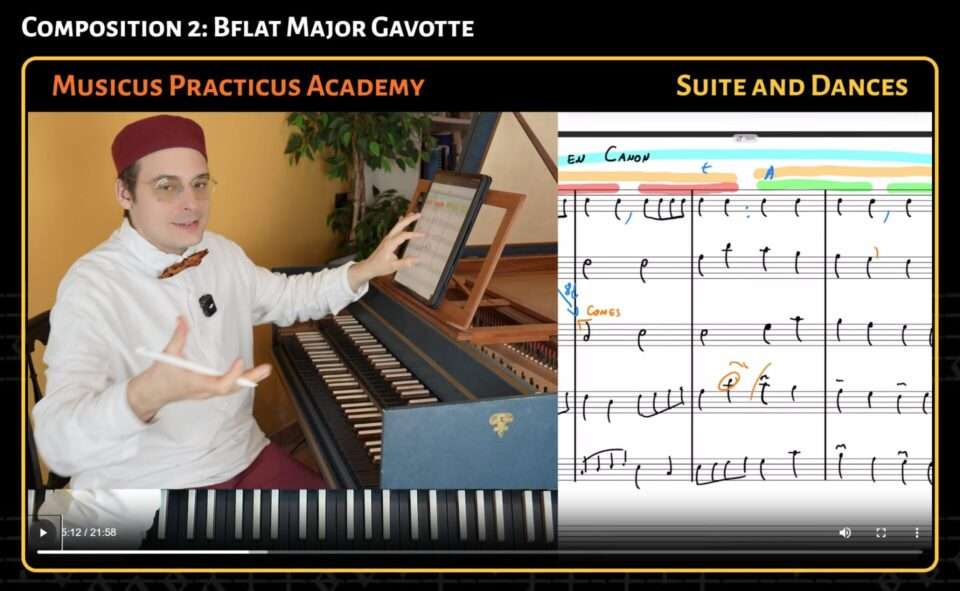
Stages
🎼 4.1 – Gavotte – Resources for the Musicus
🎼 4.2 – Compositional Elements
🎼 4.3 – Analysis 1: F. Couperin, Ordre 2, Livre 2
🎼 4.4 – Analysis 2: A. Corelli Op. 5 n. 11
🎼 4.5 – Analysis 3: J.S. Bach, French suite n. 5
🎼 4.6 – Analysis 4: J.S. Bach, English Suite n. 3
🎼 4.7 – Analysis 5: J.S. Bach, English Suite n. 3 – Musette
🎼 4.8 – Gavotte: Historical Sources
🎼 4.9 – Gavotte: AI Audio Podcast
🎼 4.10 – Composition 1: Bflat Major Gavotte
🎼 4.11 – Composition 2: B Minor Gavotte
Chapter 5: Bourée
Learn the Rhythms of the Bourrée, and Discover How to Use Syncopation to Add Drive and Energy to Your Bourrée.
Analyze Some of the Most Beautiful Bourrées Ever Written!
Learn to Compose Your Own Bourrées; Both in Major and Minor Modes.
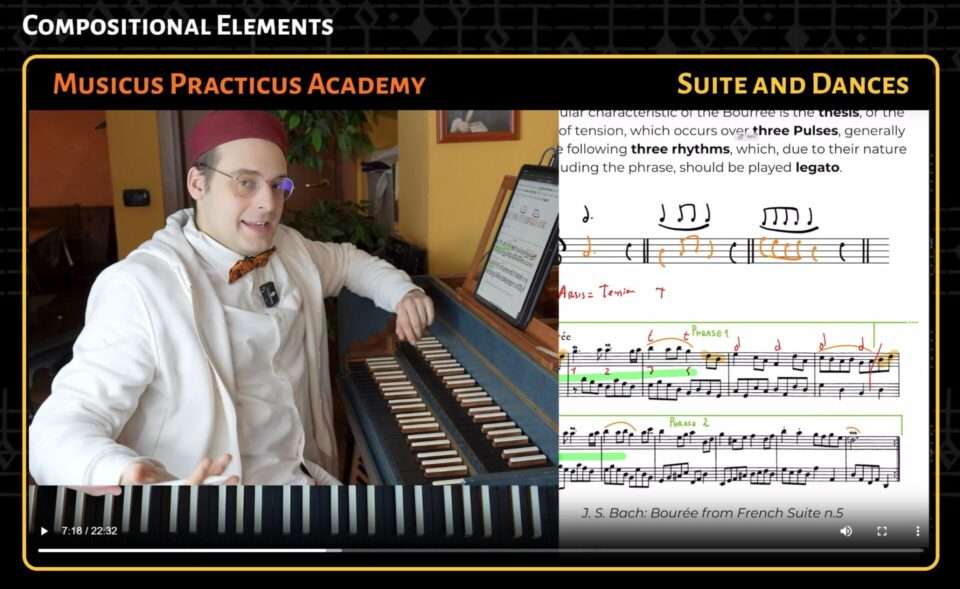
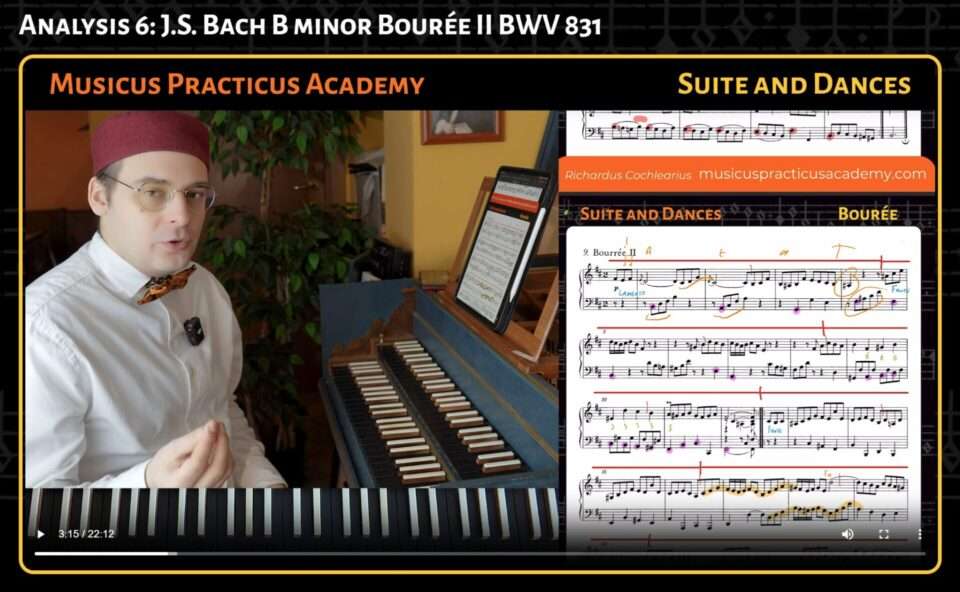
Stages
🎼 5.1 – Bourée – Resources for the Musicus
🎼 5.2 – Compositional Elements
🎼 5.3 – Analysis 1: J.S. Bach, G Major French Suite 5 BWV 816
🎼 5.4 – Analysis 2: J.S. Bach E flat Major Suite BWV 819
🎼 5.5 – Analysis 3: J.S. Bach, E Major Violin Partita BWV 1002
🎼 5.6 – Analysis 4: J.B. Lully, G Minor L’impatience LWV 14
🎼 5.7 – Analysis 5: J.S. Bach B minor Bourée I BWV 831
🎼 5.8 – Analysis 6: J.S. Bach B minor Bourée II BWV 831
🎼 5.9 – Bourée: Historical Sources
🎼 5.10 – Bourée: AI Audio Podcast
🎼 5.11 – Composition 1: Bflat Major Bourée
🎼 5.12 – Composition 2: B Minor Bourée
Chpater 6: French Courante
Learn to Handle the Key Feature of the French Courante: the Rhythmic Ambiguity Between 6/4 and 3/2.
Discover How Composers Like Bach and Couperin Wrote Their Courantes.
Compose with Me Two French Courantes, in B-flat Major and in B Minor.
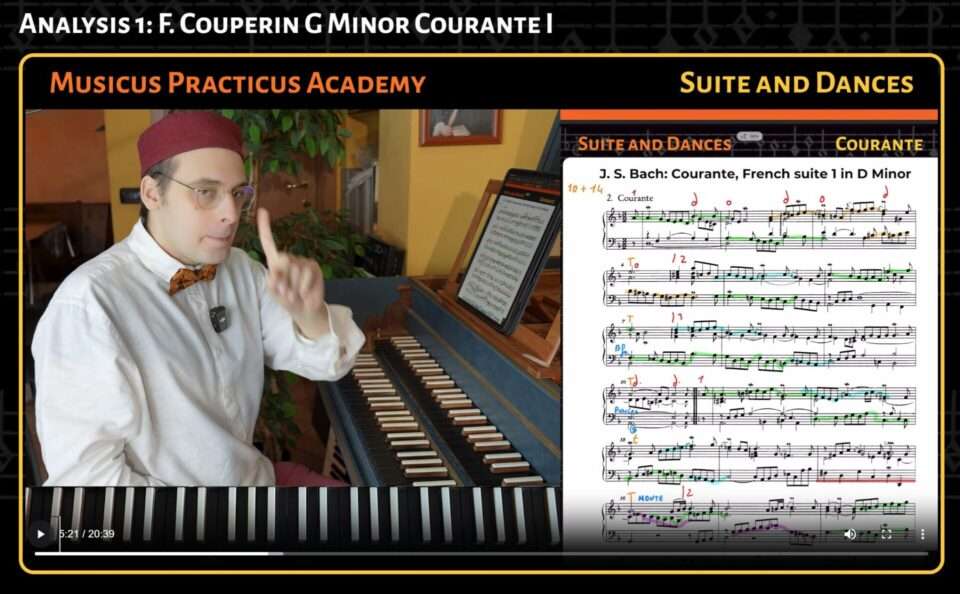
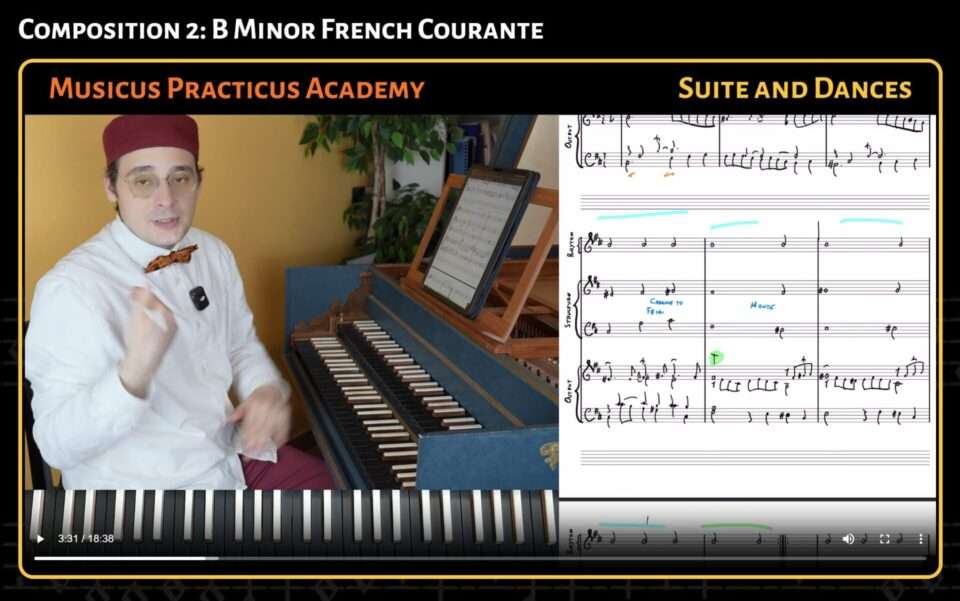
Stages
🎼 6.1 – Fr Courante – Resources for the Musicus
🎼 6.2 – Compositional Elements
🎼 6.3 – Analysis 1: F. Couperin G Minor Courante I
🎼 6.4 – Analysis 2: F. Couperin G Minor Courante II
🎼 6.5 – Analysis 3: J.S. Bach, D Minor French Suite BWV 812
🎼 6.6 – Analysis 4: J.S. Bach, A Major English Suite 1 BWV 806
🎼 6.7 – French Courante: Historical Sources
🎼 6.8 – French Courante: AI Audio Podcast
🎼 6.9 – Composition 1: Bflat Major French Courante
🎼 6.10 – Composition 2: B Minor French Courante
Chapter 7: Italian Corrente
Learn to distinguish the Italian Corrente from the French Courante: sometimes called with the same name, but with completely different character and techniques.
Discover and Analyze How Even the French Composed Italian Correntes!
Compose with Me Two Italian Correnti: One with Sixteenth Notes, the Other with Triplets!
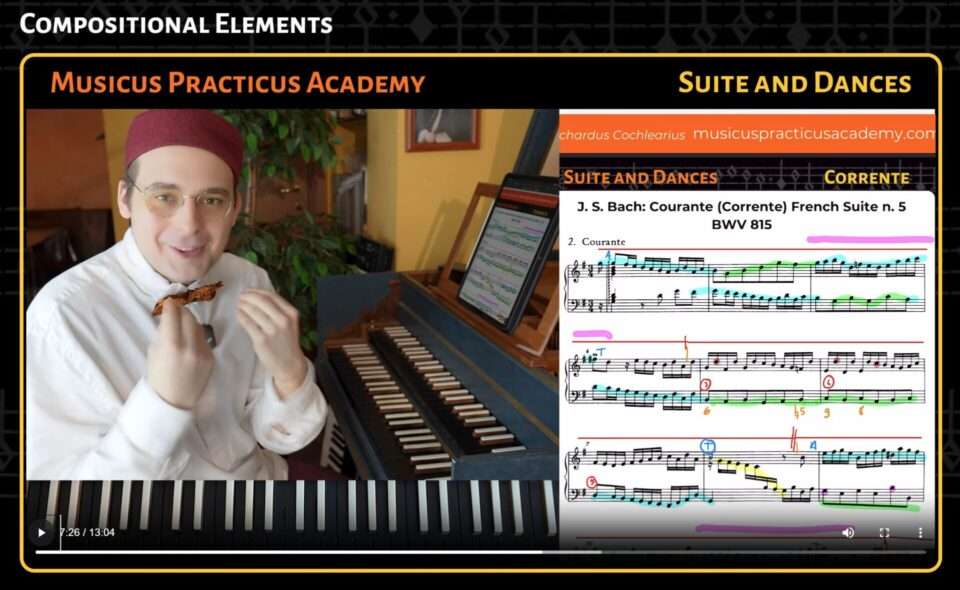
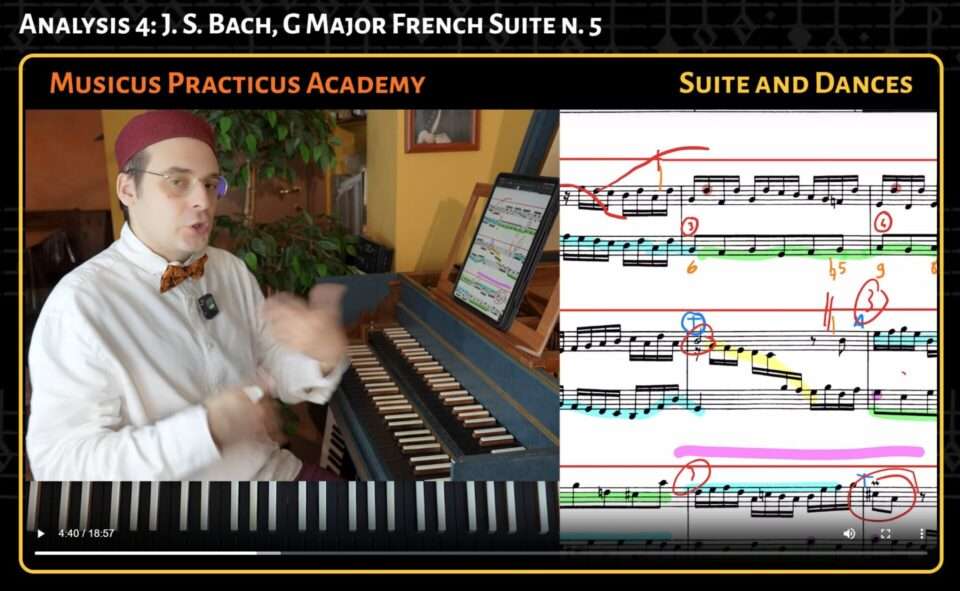
Stages
🎼 7.1 – It Corrente – Resources for the Musicus
🎼 7.2 – Compositional Elements
🎼 7.3 – Analysis 1: F. Couperin, Concerts Royaux 4
🎼 7.4 – Analysis 2: A. Corelli, Sonata a Tre op. 4 n. 11
🎼 7.5 – Analysis 3: J.S. Bach Corrente, Eflat Major French Suite 4
🎼 7.6 – Analysis 4: J. S. Bach, G Major French Suite n. 5
🎼 7.7 – Analysis 5: J.S. Bach, E Minor Invention n. 6
🎼 7.8 – Analysis 6: G. Frescobaldi, Correnti
🎼 7.9 – Italian Corrente: Historical Sources
🎼 7.10 – Italian Corrente: AI Audio Podcast
🎼 7.11 – Composition 1: Bflat Major Italian Corrente
🎼 7.12 – Composition 2: B Minor Italian Corrente
Chapter 8: Passepied
Learn to Use the Metric Scheme of the Passepied Correctly, and How to Tell It Apart from the Minuet: They may share similar phrasing, but their character is completely different
Analyze Passepieds by Various Composers: from Couperin and Dandrieu to J. S. Bach, and Learn the Techniques They Used!
Compose with Me Two Passepieds per Dance, Using Strong and Unexpected Rhythms, as Every Real Passepied Demands!

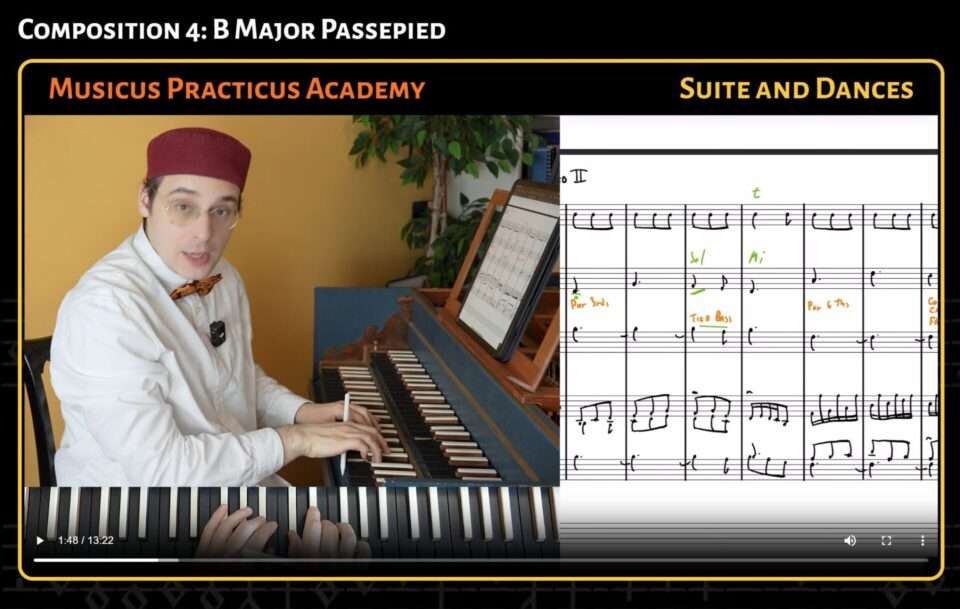
Stages
🎼 8.1 – Passepied – Resources for the Musicus
🎼 8.2 – Compositional Elements
🎼 8.3 – Analysis 1: G. Le Roux, F Major
🎼 8.4 – Analysis 2: C. Dieupart, D Major
🎼 8.5 – Analysis 3: F. Couperin D Minor
🎼 8.6 – Analysis 4: J.S. Bach, E Minor English Suite 5 BWV 810
🎼 8.7 – Analysis 5: J.S. Bach, G Major Partita BWV 829
🎼 8.8 – Analysis 6: J.S. Bach, B Minor French Ouverture, Passepied I and II BWV 831
🎼 8.9 – Analysis 7: J.S. Bach, C Major Orchestral Suite BWV 1066 I and II
🎼 8.10 – Passepied: Historical Sources
🎼 8.11 – Passepied: AI Audio Podcast
🎼 8.12 – Composition 1: Bflat Major Passepied
🎼 8.13 – Composition 2: B flat Minor Passepied
🎼 8.14 – Composition 3: B Minor Passepied
🎼 8.15 – Composition 4: B Major Passepied
Chapter 9: Loure
One of the Main Characteristics of the Loure is Its Heaviness:
Learn how to use it effectively by discovering how various composers have achieved it!
The Famous Loure from Bach’s French Suite No. 5 Will No Longer Hold Secrets!
Write with Me Two Loures: One in B-flat Major and One in B Minor.
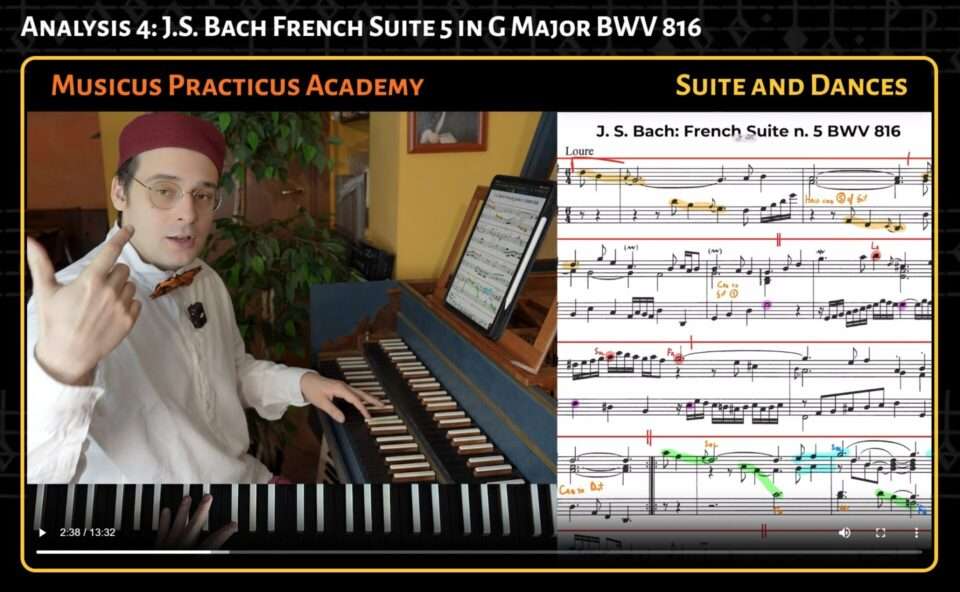
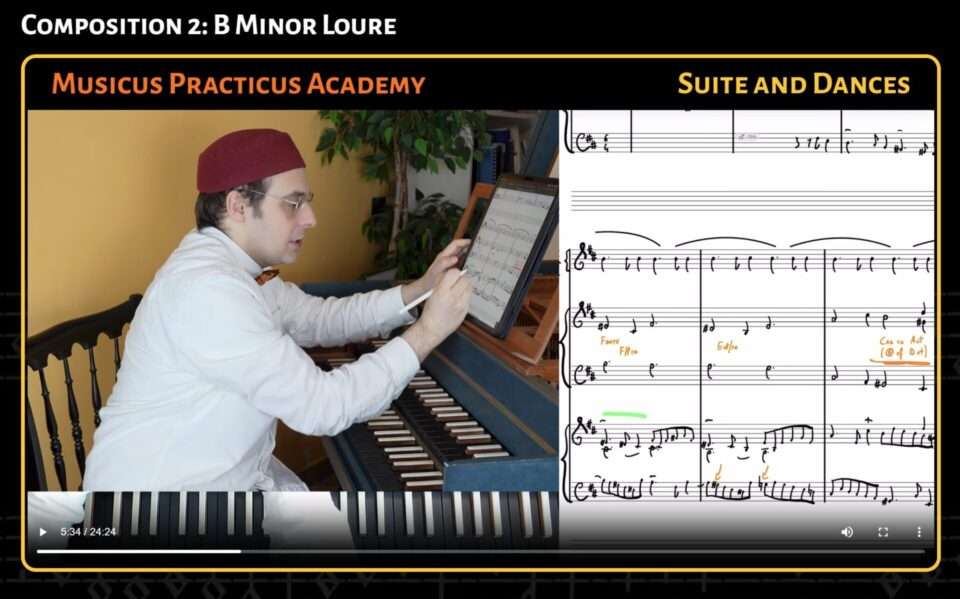
Stages
🎼 9.1 – Loure – Resources for the Musicus
🎼 9.2 – Compositional Elements
🎼 9.3 – Analysis 1: Couperin G Major
🎼 9.4 – Analysis 2: Telemann E minor Ouverture
🎼 9.5 – Analysis 3: J.S. Bach E major Violin Partita BWV 1006
🎼 9.6 – Analysis 4: J.S. Bach French Suite 5 in G Major BWV 816
🎼 9.7 – Analysis 5: J.S. Bach, G Major Partita BWV 829
🎼 9.8 – Loure: Historical Sources
🎼 9.9 – Composition 1: Bflat Major Loure
🎼 9.10 – Composition 2: B Minor Loure
Chapter 10: French and Italian Gigue
Discover the Differences Between French and Italian Gigues and Their Distinct Rhythms.
Compose with Me Four Gigues, Including One in the French Style:
And Another in the Italian Style, Written as a Fugue!
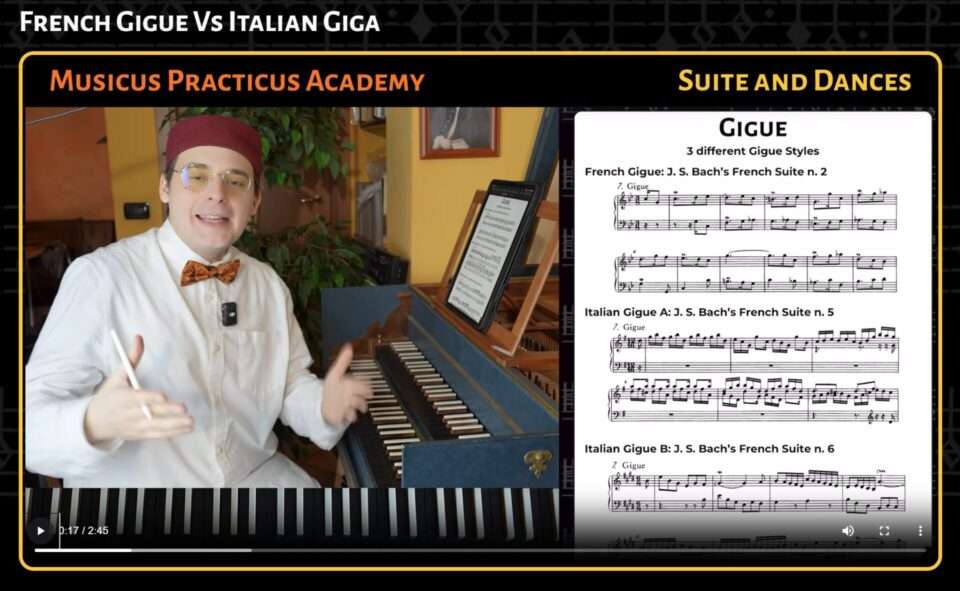
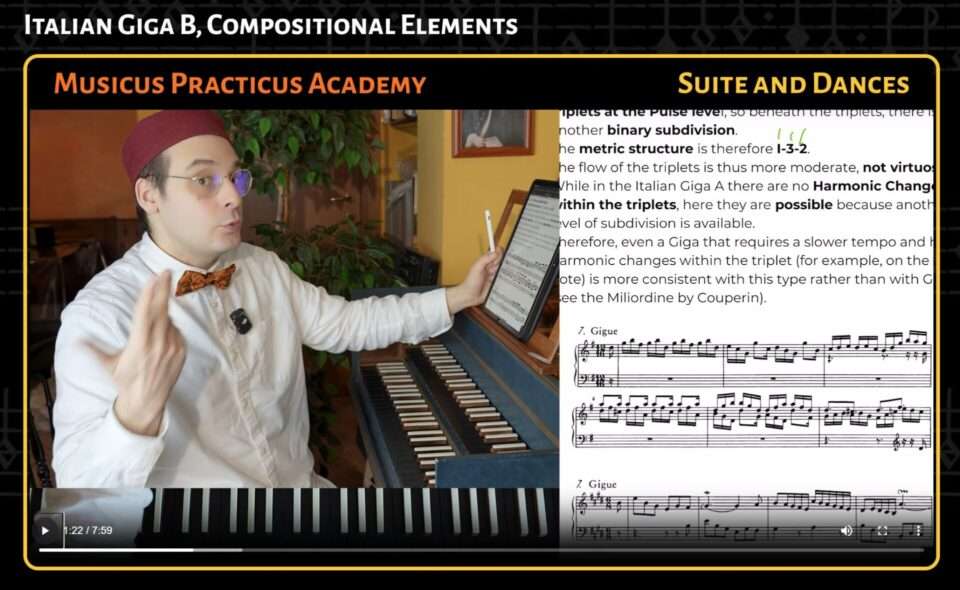
Stages
🎼 10.1 – Giga: Resources for the Musicus
🎼 10.2 – French Gigue Vs Italian Giga
🎼 10.3 – French Gigue: Compositional Elements
🎼 10.4 – FG: Analysis 1: J.S. Bach, C Minor French Suite 2 BWV 813
🎼 10.5 – FG: Analysis 2: J.F. Dandrieu, D Minor
🎼 10.6 – Analysis 4: J.S. Bach, E Minor English Suite 5 BWV 810
🎼 10.7 – FG: Analysis 3: M. Montéclair, A Major
🎼 10.8 – Italian Giga A, Compositional Elements
🎼 10.9 – IGA: Analysis 1: D. Buxtehude C Major Suite BuxWV 226
🎼 10.10 – IGA: Analysis 2: A. Corelli A Major, Op. 5 No. 9
🎼 10.11 – IGA: Analysis 3: G.F. Handel, E Minor Suite HWV 438
🎼 10.12 – IGA: Analysis 4: J.S. Bach, G Major French Suite 5 BWV 816
🎼 10.13 – IGA: Analysis 5: J.S. Bach, A Minor English Suite 2 BWV 807
🎼 10.14 – IGA: Analysis 6: J.S. Bach, D Major Partita 4 BWV 828
🎼 10.15 – Italian Giga B, Compositional Elements
🎼 10.16 – IGB: Analysis 1: J.S. Bach A Major English Suite 1 BWV 806
🎼 10.17 – IGB: Analysis 2: F. Copering, G Minor La Miliordine
🎼 10.18 – IGB – Analysis 3: J. S. Bach, B Minor French Suite n. 3 BWV 814
🎼 10.19 – IGB – Analysis 4: J.S. Bach, E Flat Major French Suite 4 BWV 815
🎼 10.20 – Gigue in Duple Meter
🎼 10.21 – Gigue: Historical Sources
🎼 10.22 – Gigue: AI Audio Podcast
🎼 10.23 – Composition 1: French Gigue in Bflat Major
🎼 10.24 – Composition 2: Italian Giga in B Minor
🎼 10.25 – Composition 3: Italian Giga Fugue in Bflat Major
🎼 10.26 – Composition 4: Italian Giga Fugue in B Minor
120+ Lessons

120+ Stages and Video Lessons that you can watch and study anytime you want, from the online platform.
400 Pages

400 PDF pages of examples
exercises, and resources to follow the lessons, take notes, and do plenty of practice.
Questions

Comment under each stage to ask your questions and satisfy your curiosity as a Musicus Practicus.
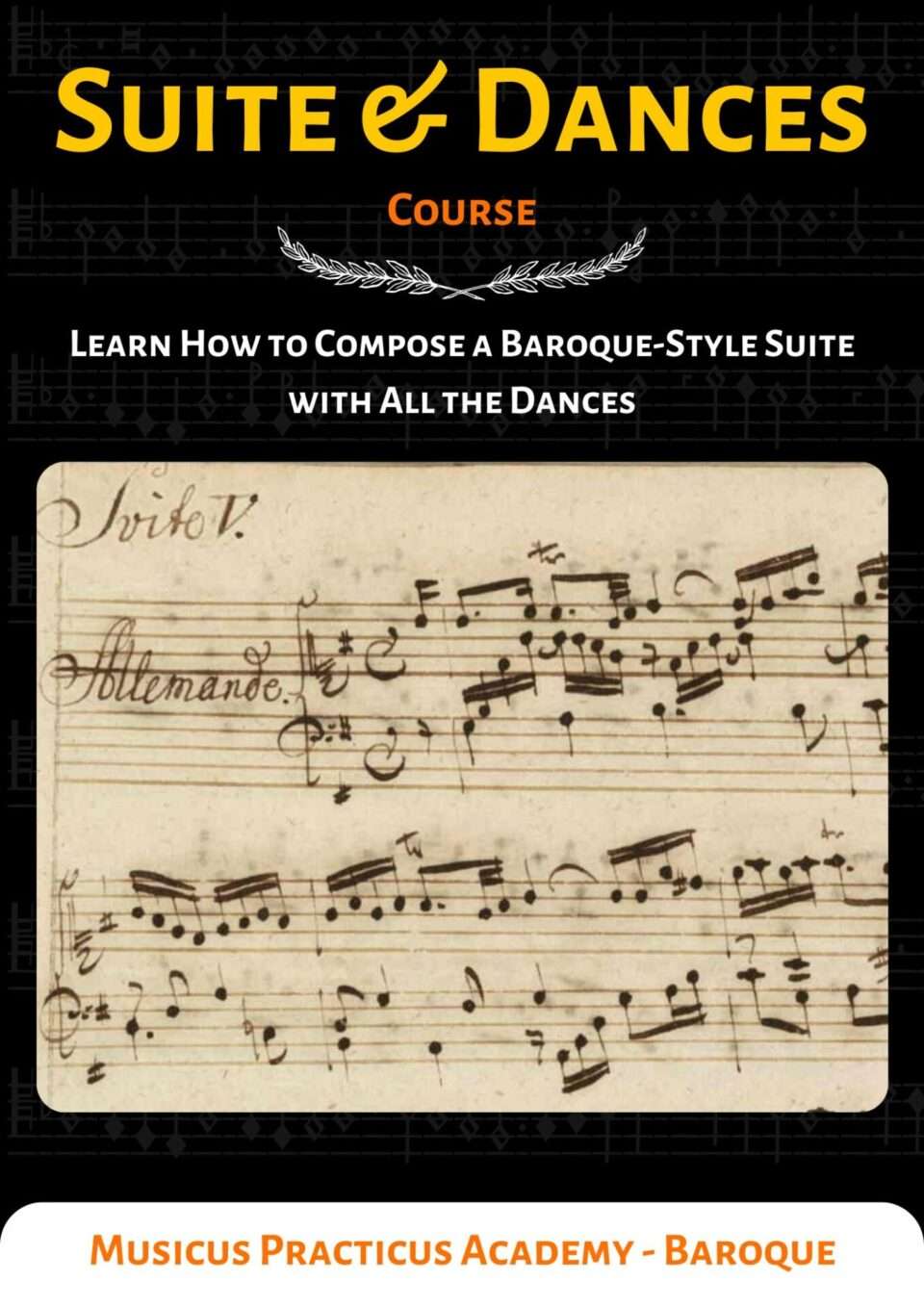
Learn More about Suite and Dances!
Discover everything you will learn and preview some images we’ll use to learn together!

